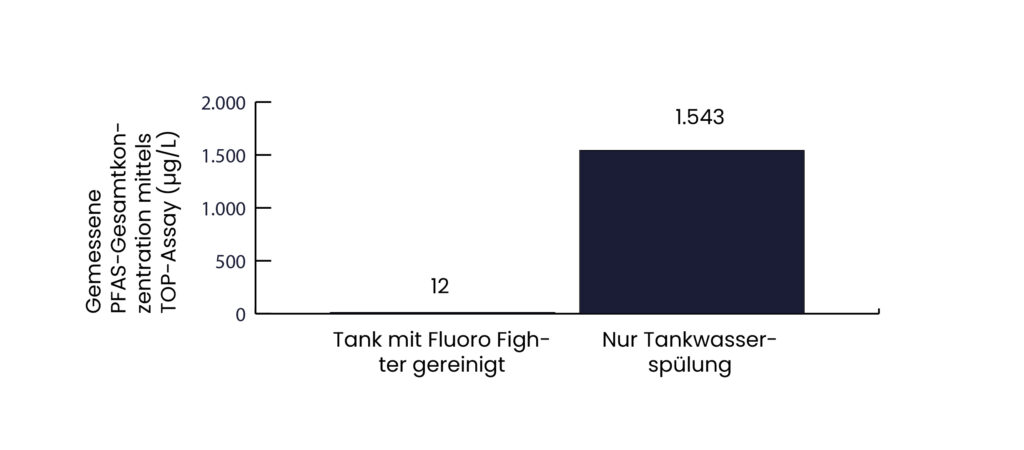Background knowledge
Remove PFAS from extinguishing systems
Per- and polyfluorinated alkyl substances (PFAS) are persistent organic substances. They are persistent, i.e. hardly degradable in the environment. Due to their properties, they were used in fire-fighting foam concentrates for many years. The new legal situation restricts this application. After switching to PFAS-free foam concentrates, it is necessary to remove the remaining quantities of PFAS in extinguishing systems and dispose of them properly.
Arcadis
Cleaning with FluoroFighter™
Specialist companies have specialized in this type of cleaning and offer appropriate solutions. Arcadis is one of these service providers. With the help of a special cleaner (Fluoro FighterTM), it is possible to impressively remove PFAS residues from containers.

Container cleaning with and without Fluoro FighterTM (source: www.enviro.wiki)
PFAS in pipelines
Cleaning pipes and systems
In contrast to containers, the cleaning of pipes and systems is different. Rinsing with solvents or water-based cleaning agents is common. This works well for cleaning pipes with smooth surfaces and fairly fresh PFAS deposits. Aged deposits and PFAS deposits in areas with poor flow or in corrugated pipes in heated areas of extinguishing systems are problematic. The combination of Fluoro FighterTM with Comprex® technology makes it possible to efficiently clean all these areas of the extinguishing systems as well as to mobilize and then completely remove aged PFAS deposits in areas with poor flow.
Waste water containing PFAS is produced during cleaning. Special equipment is required to handle and dispose of the pollutants properly. These include pressure-resistant decompression tanks to separate solids and air from the water containing the cleaning agent. The solids are then disposed of properly. Activated carbon filters clean the exhaust air. These tasks are carried out by another specialized company.
The following picture shows Comprex®units before use in industrial buildings and treatment plants for PFAS-containing wastewater.



Comprex® unit before use in industrial buildings and treatment plants for PFAS-containing wastewater.
Efficient procedure
Our service offerings at a glance
Fundamentals
Perfluorinated and polyfluorinated alkyl substances (PFAS) are persistent substances. These persistent organic substances are hardly degradable in the environment. If such substances have properties that are harmful to humans and the environment and also have the ability to spread over long distances in the environment, they are persistent organic pollutants (POPs).
The EU has restricted the use of some PFAS, further restrictions are in preparation.
More information: www.umweltbundesamt.de
PFAS were used in foaming agents to form a water film between the fuel and the foam and thus effectively fight the fire. The so-called Aqueous Film Forming Foam (AFFF) consisted of various compounds, mainly perfluorinated acids and their salts with different molecular sizes. Due to the large number of compounds, it is difficult to regulate their use.
Requirements are based on reliable analytical methods. PFAS contents in AFFF can be determined using various methods. In addition to single substance analysis, it is also possible to determine sum parameters such as TOP assay, adsorbable organic fluorine (AOF) or extractable organic fluorine (EOF). Chromatographic methods in combination with mass spectrometry or adsorption methods are suitable for extremely low concentrations.
Of all the methods mentioned here, single substance analysis has the lowest limit of quantification. The concentrations are in the range of 1 ng/l to 5 ng/l for water samples and in the range of 10 µg/l to 100 μg/l for foam concentrate samples. However, an analytical standard must be available for each substance. So far, such standards are available for less than 100 PFAS. Sum parameters cover several compounds.
Standards for the determination of PFAS and PFC
The comparability of the analysis results and the setting of rules require a standard procedure.
However, there is currently no legally prescribed or standardized analysis procedure for fire extinguishing foams.
In addition to AFFF, fluorine-containing foam concentrates or extinguishing agents also include the lesser-known FFFP and FP foam concentrates (FFP = Film Forming Fluoroprotein and FP = Fluoro Protein). In addition to these PFAS-containing foaming agents, high-performance fluorine-free foaming agents are now available in the form of protein or multigrade foaming agents. Depending on the type of firefighting, their effectiveness is comparable to that of AFFF. They are increasingly replacing fluorinated foam concentrates.
In collaboration with the Federal Institute for Occupational Safety and Health and ep:fire, the Federal Environment Agency has compiled a guide on the subject of replacing fire extinguishing foams containing PFAS.
https://www.umweltbundesamt.de/publikationen/austausch-von-pfas-haltigen-feuerloeschschaeumen
This guide pursues the following objectives:
- Provide information on regulations and deadlines for the use of PFAS-containing foam concentrates
- Raising awareness of the problems and challenges of substitution
- Provide recommendations for the changeover (cleaning, disposal, analysis)
Switching to PFAS-free foam concentrates
Replacing PFAS-containing foam concentrates with PFAS-free ones is not enough. PFAS residues remain on surfaces and poorly flowing areas of the extinguishing systems. While mobile containers with adhering fluorine-containing residues can be disposed of properly, special cleaning technology is required for permanently installed tanks and pipelines. Due to their low wettability, PFAS are difficult to mobilize. This has led to the development of special cleaning agents such as Fluoro FighterTM.
The cost of these cleaning agents and, above all, the cost of disposing of the PFAS-containing wastewater that is produced means that they must be used sparingly. The combination of special techniques contributes to this: water-based cleaning agents, Comprex® cleaning and appropriate waste water treatment. This combination conserves resources, i.e. significantly less fresh water for the cleaning solution and correspondingly less energy for burning the discharged solids and adsorbents. In addition, this procedure makes it possible to effectively remove PFAS residues from existing extinguishing systems.



